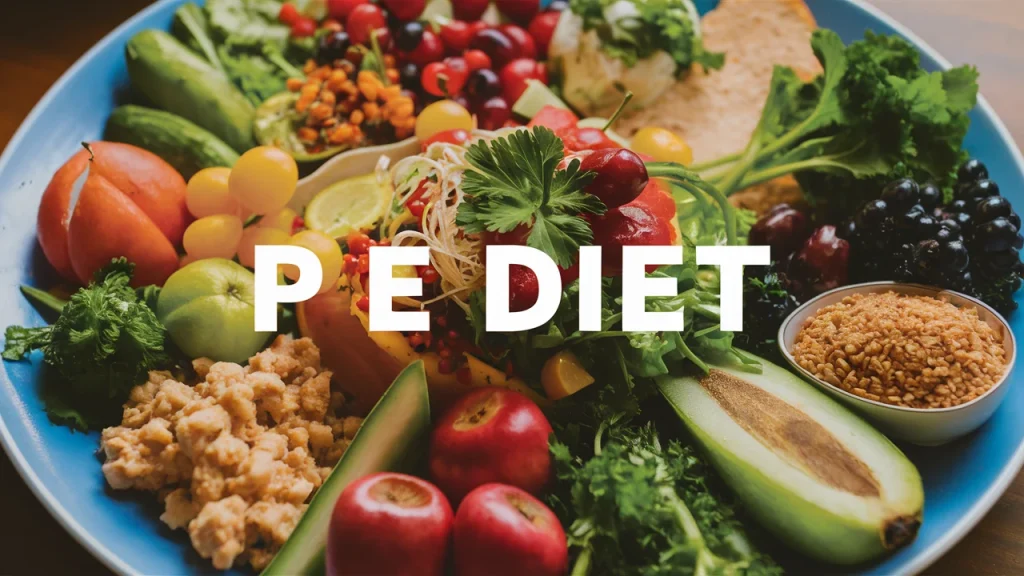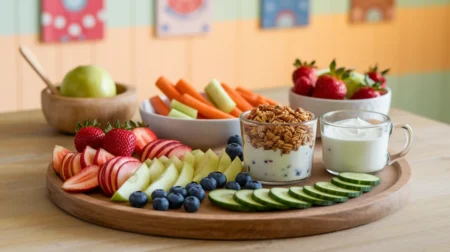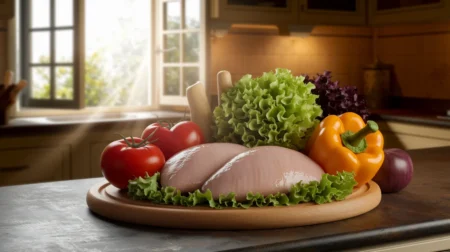Welcome to our guide on the PE Diet Food List, a comprehensive resource to help you optimize your nutrition for peak health and wellness. Whether you’re an athlete, fitness enthusiast, or simply looking to improve your overall well-being, the PE Diet offers a balanced approach to fueling your body effectively.
The PE Diet focuses on leveraging protein and energy to support your body’s needs. By understanding the right foods to include in your diet, you can enhance your performance, build muscle, and improve your overall vitality.
In this article, we will explore the key principles of the PE Diet and dive into the foods that should be included in your daily meals. We will also discuss how the PE Diet aligns with other popular eating plans, such as the Paleo diet, and provide tips on creating your personalized PE Diet grocery list.
Key Takeaways:
- The PE Diet focuses on optimizing nutrition through protein and energy sources.
- By including the right foods in your diet, you can enhance your performance and improve overall well-being.
- The PE Diet can be complemented with other eating plans like the Paleo diet for additional health benefits.
- Creating a personalized grocery list will help you stay on track with your PE Diet goals.
- Start implementing the PE Diet today to experience the benefits firsthand.
Understanding the PE Diet and Its Benefits
Before diving into the PE Diet food list, it’s important to grasp the concept behind this nutrition plan and recognize the numerous benefits it offers. The PE Diet focuses on optimizing your health and performance by emphasizing specific food options that align with the primal diet philosophy. By incorporating these ideal foods into your daily meals, you can fuel your body effectively and achieve optimal results.
The PE Diet, short for Protein and Energy Diet, recognizes the significance of protein and energy in supporting overall wellness. It prioritizes nutrient-dense foods that provide essential amino acids, vitamins, and minerals necessary for muscle growth, recovery, and sustained energy levels.
When following the PE Diet, it’s crucial to choose primal diet food options that are rich in quality protein sources, healthy fats, and beneficial carbohydrates. These foods not only provide the necessary macronutrients but also offer a wide range of micronutrients that support various organ functions and overall vitality.
“The PE Diet focuses on incorporating primal diet food options to enhance your nutrition and fuel your body effectively.”
By incorporating primal diet food options into your PE Diet, you can benefit from the following:
- Increased satiety: Protein-rich foods keep you feeling full for longer periods, reducing the likelihood of overeating or snacking on unhealthy foods.
- Muscle building and repair: Protein is essential for muscle growth and repair, enabling you to enhance your physical performance and recover efficiently after intense workouts.
- Sustained energy levels: Including energy-dense foods such as complex carbohydrates and healthy fats provides a steady release of energy throughout the day, preventing energy crashes.
- Improved nutrient absorption: By focusing on whole, unprocessed foods, the PE Diet ensures optimal nutrient absorption, allowing your body to obtain the maximum benefit from the foods you consume.
- Enhanced overall health and wellness: The PE Diet’s emphasis on nutrient-dense foods supports various aspects of your well-being, including immune function, cognitive performance, and cardiovascular health.
Primal Diet Food Options
Primal diet food options encompass a range of whole, unprocessed foods that align with the principles of the PE Diet. These include:
- Grass-fed and pasture-raised meats
- Wild-caught fish and seafood
- Organic eggs
- Quality dairy products (if tolerated)
- Fresh fruits and vegetables
- Nuts, seeds, and healthy oils
- Legumes (in moderation)
These primal diet food options are rich sources of essential nutrients, helping you achieve optimal health and performance while following the PE Diet.
| Food Group | Examples |
|---|---|
| Protein | Grass-fed beef, free-range chicken, wild-caught salmon |
| Fruits and Vegetables | Spinach, broccoli, berries, citrus fruits |
| Healthy Fats | Avocado, olive oil, coconut oil, almonds |
| Carbohydrates | Sweet potatoes, quinoa, brown rice, lentils |
| Dairy (if tolerated) | Organic milk, Greek yogurt, grass-fed butter |
| Nuts and Seeds | Walnuts, chia seeds, flaxseeds |
By incorporating these primal diet food options into your meals, you can ensure your PE Diet is well-balanced, providing the essential nutrients needed to optimize your health, well-being, and physical performance.
Incorporating Paleo Foods into Your PE Diet
The PE Diet and the Paleo eating plan share a common emphasis on whole, unprocessed foods, making them compatible partners in optimizing your nutrition. By incorporating the best paleo diet foods into your PE Diet, you can further enhance the health benefits and diversify your meal options. Here are some key paleo-friendly foods that you can include:
Paleo Meat and Seafood
Add quality sources of protein to your PE Diet with paleo-friendly meats and seafood. Grass-fed beef, free-range chicken, wild-caught salmon, and shrimp are excellent options. These protein sources are not only delicious but also rich in essential nutrients.
Fresh Fruits and Vegetables
Fruits and vegetables form a crucial part of both the PE Diet and the paleo eating plan. They provide essential vitamins, minerals, and fiber, promoting overall health. Incorporate a variety of colorful options such as berries, leafy greens, sweet potatoes, and broccoli into your meals.
Healthy Fats
Include sources of healthy fats in your PE Diet for sustained energy and satiety. Avocado, olive oil, coconut oil, and nuts like almonds and walnuts are paleo-friendly choices that provide essential fatty acids and contribute to a well-rounded diet.
Nutrient-Dense Snacks
When hunger strikes between meals, paleo snacks can be a nutritious and satisfying option. Keep paleo-friendly snacks like beef jerky, hard-boiled eggs, mixed nuts, and fresh fruit handy for a quick and convenient energy boost.
Integrating these paleo diet foods into your PE Diet not only adds variety but also promotes a balanced approach to nutrition. To maximize the benefits, try incorporating paleo-friendly recipes and meal ideas that align with your PE Diet goals. Prepare delicious meals that are easy to make, enjoyable to eat, and support your health and wellness journey.
Exploring Other Diet Options for the PE Diet
While the PE Diet may primarily focus on protein and energy, there are other diet options that can complement your nutrition plan. Exploring different diets can provide variety and ensure you’re getting a wide range of nutrients in your meals. Let’s delve into some popular diets and their respective food lists that you can incorporate into your PE Diet.
The Keto Diet
The keto diet, short for ketogenic diet, is a low-carb, high-fat eating plan that has gained popularity for its potential weight loss and health benefits. The main principle of the keto diet is to shift your body into a state of ketosis, where it burns fat for fuel instead of carbohydrates. This diet typically involves consuming foods high in healthy fats, moderate amounts of protein, and very few carbohydrates. Some keto-friendly foods include:
- Eggs
- Avocados
- Fatty fish, such as salmon and tuna
- Low-carb vegetables like spinach, kale, and cauliflower
The Mediterranean Diet
The Mediterranean diet is inspired by the traditional eating patterns of people from countries bordering the Mediterranean Sea. It is known for its emphasis on whole, unprocessed foods, such as fruits, vegetables, whole grains, legumes, and lean proteins. This diet also encourages the consumption of heart-healthy fats, like olive oil and nuts. Some Mediterranean diet foods include:
- Olive oil
- Vegetables, such as tomatoes, cucumbers, and bell peppers
- Fruits, like grapes, oranges, and figs
- Whole grains, such as quinoa and whole wheat bread
The Low Carb Diet
A low carb diet focuses on reducing the intake of carbohydrates, including refined grains, sugars, and starchy foods. By limiting carbs, this eating plan aims to stabilize blood sugar levels, promote weight loss, and improve overall health. Some low carb diet foods include:
- Lean meats, such as chicken, turkey, and beef
- Fatty fish, like salmon and mackerel
- Non-starchy vegetables, such as broccoli, spinach, and zucchini
- Nuts and seeds
The Vegan Diet
A vegan diet excludes all animal products and focuses on plant-based foods. It emphasizes the consumption of fruits, vegetables, whole grains, legumes, and plant-based proteins. Some vegan diet foods include:
- Beans and legumes, such as chickpeas and lentils
- Tofu and tempeh
- Quinoa and other whole grains
- Nuts and seeds
The Whole30 Diet
The Whole30 diet is a 30-day program that eliminates certain food groups, such as grains, dairy, legumes, added sugars, and processed foods. It aims to reset your body and identify any potential food sensitivities. Some Whole30-approved foods include:
- Meat, such as grass-fed beef and chicken
- Seafood
- Eggs
- Vegetables, such as sweet potatoes, carrots, and Brussels sprouts
The Atkins Diet
The Atkins diet is a low-carb eating plan that focuses on protein and fat consumption while limiting carbohydrates. It consists of several phases designed to gradually reintroduce carbs while maximizing weight loss. Some Atkins diet foods include:
- Eggs
- Poultry, such as chicken and turkey
- Fatty fish
- Low-carb vegetables like zucchini, cauliflower, and broccoli
The Gluten-Free Diet
A gluten-free diet excludes gluten, a protein found in wheat, barley, and rye. It is essential for individuals with celiac disease or gluten sensitivity. Some gluten-free diet foods include:
- Gluten-free grains, such as rice, quinoa, and millet
- Fruits and vegetables
- Lean proteins, like chicken and fish
- Nuts and seeds
By incorporating certain foods from these popular diets into your PE Diet, you can expand your options and enjoy a diverse range of flavors, nutrients, and health benefits.
| Diet | Key Features | Example Foods |
|---|---|---|
| Keto Diet | Low-carb, high-fat | Eggs, avocados, fatty fish, low-carb vegetables |
| Mediterranean Diet | Whole, unprocessed foods | Olive oil, vegetables, fruits, whole grains |
| Low Carb Diet | Reduces carb intake | Lean meats, fatty fish, non-starchy vegetables |
| Vegan Diet | Plant-based | Beans and legumes, tofu, quinoa, nuts |
| Whole30 Diet | Eliminates certain food groups | Meat, seafood, eggs, vegetables |
| Atkins Diet | Protein-focused, low-carb | Eggs, poultry, fatty fish, low-carb vegetables |
| Gluten-Free Diet | Excludes gluten | Gluten-free grains, fruits, lean proteins, nuts |
Creating Your PE Diet Grocery List
Building a PE Diet grocery list is essential for staying on track with your nutrition goals. By selecting PE Diet approved foods and stocking up on them, you can ensure that you always have the necessary ingredients to prepare nutritious meals that support your health and fitness.
Here is a breakdown of some key food categories to consider when creating your PE Diet grocery list:
- Protein-Rich Foods:
| Protein-Rich Foods | Sources |
|---|---|
| Lean Meats | Chicken breast, turkey, lean cuts of beef |
| Fish and Seafood | Salmon, tuna, shrimp, cod |
| Eggs | Chicken eggs, liquid egg whites |
| Plant-Based Proteins | Chickpeas, lentils, tofu, tempeh |
- Fruits and Vegetables:
- Leafy Greens: Spinach, kale, romaine lettuce
- Citrus Fruits: Oranges, grapefruits, lemons
- Berries: Strawberries, blueberries, raspberries
- Cruciferous Vegetables: Broccoli, cauliflower, Brussels sprouts
- Root Vegetables: Carrots, sweet potatoes, beets
- Whole Grains and Legumes:
- Quinoa
- Brown rice
- Chickpeas
- Lentils
Remember to choose whole grains and complex carbohydrates over refined options to maximize nutrient intake and support steady energy levels.
Tip: When creating your PE Diet grocery list, focus on selecting fresh, whole foods rather than processed or packaged items. Prioritize natural ingredients to ensure the highest nutritional value and avoid unnecessary additives or preservatives.
Meal Planning Made Easy
Planning your meals in advance can greatly simplify the process of sticking to your PE Diet. Consider organizing your grocery list based on specific meals or recipes you intend to prepare throughout the week. This approach can help you stay organized and ensure that you have all the ingredients on hand.
Additionally, incorporating a variety of flavors, textures, and colors into your meals can make the PE Diet more enjoyable and satisfying. Experiment with different combinations of proteins, fruits, vegetables, and grains to keep your taste buds excited and your body nourished.
When you have a well-structured PE Diet grocery list, grocery shopping becomes more efficient and stress-free. You can confidently stock your pantry and refrigerator with the foods that align with your nutritional goals, making it easier to stay on track with your PE Diet.
Conclusion
In conclusion, optimizing your nutrition with the PE Diet Food List can have a significant impact on your overall health and well-being. By incorporating the recommended foods and understanding the principles behind the PE Diet, you can fuel your body efficiently and reach your wellness goals.
Implementing the PE Diet is a journey towards a healthier lifestyle. By following the PE Diet Food List and focusing on protein and energy-rich foods, you can enhance your performance, improve muscle recovery, and boost your energy levels.
So, why wait? Start your PE Diet today and experience the benefits firsthand. By fueling your body with the right nutrients, you’ll not only support your physical health but also improve your mental clarity and overall well-being. Take control of your nutrition and unlock your full potential with the power of the PE Diet.
FAQ
What is the PE Diet Food List?
The PE Diet Food List is a comprehensive guide that outlines the best foods to include in your nutrition plan to optimize protein and energy intake for peak health and wellness.
How does the PE Diet benefit my nutrition?
The PE Diet focuses on leveraging protein and energy to fuel your body effectively. By following this approach, you can enhance your athletic performance, support muscle recovery, and maintain overall well-being.
Can I incorporate Paleo foods into my PE Diet?
Absolutely! The PE Diet is compatible with the Paleo eating plan. You can enjoy a wide range of whole, unprocessed paleo foods that are rich in nutrients and align with the PE Diet philosophy.
What are some of the best Paleo diet foods for the PE Diet?
Some of the best Paleo diet foods to incorporate into your PE Diet include lean meats, fish, fruits, vegetables, nuts, and seeds. These foods provide ample protein and energy to support your fitness goals.
Are there other diet options that complement the PE Diet?
Yes, there are several other diet options that can complement your PE Diet. Consider exploring food lists from diets such as the keto diet, Mediterranean diet, low carb diet, vegan diet, Whole30 diet, Atkins diet, and gluten-free diet to add variety to your nutrition plan.
How can I create a personalized PE Diet grocery list?
To create your PE Diet grocery list, refer to the approved foods for the PE Diet. Include a variety of protein sources, such as lean meats, poultry, fish, and plant-based options, as well as energy-rich foods like whole grains, fruits, and vegetables. Don’t forget to stock up on healthy fats, nuts, and seeds as well.











